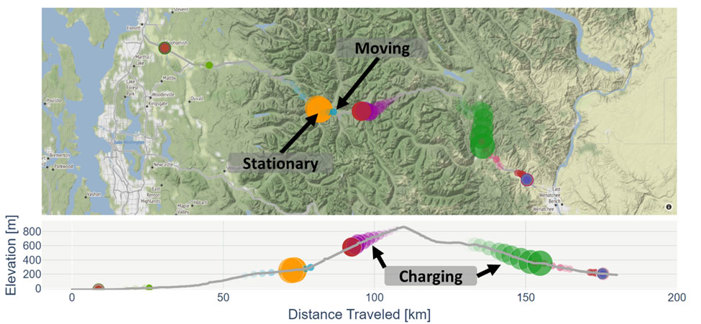Known as ALTRIOS, the Advanced Locomotive Technology and Rail Infrastructure Optimization System, the software can simulate the real-world impacts and expenses related to adopting alternative energy locomotive technologies and expanding associated infrastructure.
Now publicly available for download, ALTRIOS supports several simulation modes to provide rail industry stakeholders with optimal strategies for implementing greenhouse gas emissions (GHG) reduction technologies and making necessary infrastructure changes.
ALTRIOS combines locomotive and energy storage technology modeling with a suite of train dispatch and corridor simulations alongside a high-level train scheduling and routing tool. It uses a physics-based simulation of individual trains and real-world rail infrastructure to evaluate the effectiveness of different decarbonization technologies, including hydrogen, biofuels, and batteries, among many others, across the US over the course of decades.
“The Class-I North American railroads have already committed to reducing their GHG emissions by setting science-based carbon reduction targets,” said Garrett Anderson, a lead engineer in SwRI’s Powertrain Engineering Division. “Railroads are using fuel efficiency, renewable fuels, and alternate propulsion approaches to achieve the goal. ALTRIOS can cost-effectively assess locomotive decarbonization approaches using computer modeling to help them choose the right technologies for their needs.”
ALTRIOS was funded by the US Department of Energy’s Advanced Research Projects Agency – Energy (ARPA-E) as part of the LOCOMOTIVES (Lowering CO2: Models to Optimize Train Infrastructure, Vehicles and Energy Storage) program. It received funding of US$1.5m. SwRI helped develop the software with the National Renewable Energy Laboratory (NREL), the University of Texas at Austin, the University of Illinois Urbana-Champaign RailTec and BNSF Railway.
The SwRI Locomotive Technology Center supported the ALTRIOS project by providing an extensive collection of locomotive power, efficiency, and fuel consumption data, helping with simulation and modeling work, and sharing locomotive battery testing expertise.
SwRI regularly performs locomotive exhaust emission, alternative fuel and engine technology research, development and evaluations for original equipment manufacturers and railroads.
SwRI’s work also supports the US Environmental Protection Agency, the California Air Resources Board, the US Department of Transportation and the US Department of Energy.
“Southwest Research Institute has extensive expertise in large-scale propulsion systems technologies and closely collaborated with BNSF Railway to test battery-electric locomotives in California,” said Jason Lustbader, who leads NREL’s advanced vehicles and charging infrastructure research group. “The SwRI team’s collaboration, knowledge and extensive data processing and modeling helped us to make ALTRIOS the first fully validated, comprehensive model for rail decarbonization.”
The largest freight railroads in North America aim to reduce GHG emissions by 40% within the next decade. ALTRIOS is a tool designed to tackle the unique challenges facing the industry’s push for decarbonization, such as propulsion power requirements, assessing scheduling impacts and addressing the wide geographic distribution of fuel and energy supply infrastructure. According to NREL, its researchers have already used ALTRIOS to begin development of real-world decarbonization strategies.
“It will cost billions of dollars to upgrade existing rail infrastructure for decarbonization,” said Steven Fritz, who leads SwRI’s Locomotive Technology Center. “With that much money on the line, we must carefully evaluate decarbonization proposals to ensure they are efficiently and effectively implemented.”
ALTRIOS is publicly available for download under an open-source license and is compatible with Windows, MAC OS and Linux.

Above: The SwRI Locomotive Technology Center provided an extensive collection of locomotive and railway data, simulation and modeling work, and locomotive battery testing expertise to support the ALTRIOS project. Image courtesy of ALTRIOS/SwRI

